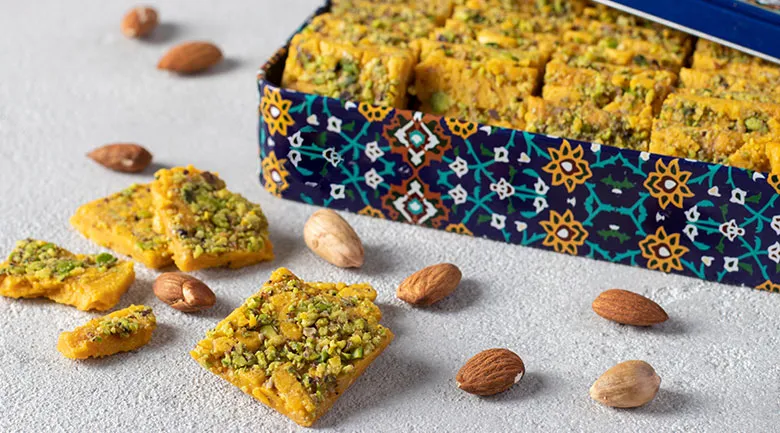When you think of Persian cuisine, two ingredients that often come to mind are pomegranates and pistachios. Both are more than just flavorful additions to dishes—they are deeply symbolic and have been cherished in Persian culture for centuries. From the sweet-tart juiciness of pomegranates to the earthy crunch of pistachios, these ingredients are integral to Persian cooking and carry a profound cultural and historical significance.
Let’s explore the cultural importance of pomegranates and pistachios in Persian food, their symbolic meanings, and how they enhance the vibrant flavors of Persian cuisine.
🍊 The Pomegranate: Symbol of Life, Fertility, and Perseverance
The pomegranate is one of the most iconic fruits in Persian culture, appearing in art, literature, and folklore. It has been cultivated in the region for thousands of years, and its ruby-red seeds are not only beautiful but are also imbued with symbolic meaning. Here are some of the ways pomegranates hold significance in Persian culture:
Symbolism of the Pomegranate
-
Life and Fertility: In Persian mythology, the pomegranate symbolizes fertility and renewal. The fruit’s many seeds are often seen as a metaphor for the abundance of life and the continuous cycle of birth and growth. This symbolism also ties into the fruit’s association with the coming of spring, a time of renewal in nature, which is celebrated in the Persian New Year (Nowruz).
-
Immortality and Perseverance: According to Persian tradition, the pomegranate is also thought to symbolize immortality and perseverance. The fruit’s tough outer shell protects its delicate seeds, and this is often seen as a metaphor for the strength needed to endure life’s challenges.
-
Symbol in Art and Culture: The pomegranate appears in Persian art, often depicted in miniatures, pottery, and textiles. It is also a recurring theme in Persian poetry, where its seeds are seen as symbols of love, unity, and beauty.
The Pomegranate in Persian Food
Pomegranates are a central ingredient in many Persian dishes, and their sweet-tart flavor adds a distinct vibrancy to Persian cuisine. Some notable uses include:
-
Fesenjan: A rich, tangy stew made with pomegranate molasses and ground walnuts. The pomegranate provides a unique balance of sweetness and acidity that perfectly complements the savory, deep flavor of the dish.
-
Pomegranate Salad (Shirazi Salad): A refreshing salad made with tomatoes, cucumbers, onions, and pomegranate seeds, often dressed with olive oil and lime juice. The pomegranate adds a burst of color and sweetness to the salad.
-
Desserts: Pomegranate molasses is used to add depth to many Persian desserts, from cakes to syrups, often paired with other elements like rosewater or saffron to create a balanced, aromatic sweetness.
🌰 Pistachios: The Nut of Royalty and Generosity
The pistachio, another iconic ingredient in Persian cuisine, has been cultivated in Iran for over 2,000 years, and today, it remains one of the most widely exported products from the country. Its rich, buttery flavor and crunchy texture make it a versatile ingredient in both savory and sweet dishes. But beyond its flavor, pistachios hold a place of symbolic importance in Persian culture.
Symbolism of Pistachios
-
Generosity and Hospitality: Pistachios are often associated with hospitality and generosity in Persian culture. Offering pistachios to guests is a common practice, symbolizing the host's desire to share abundance and make guests feel welcome. In this sense, pistachios represent warmth and community, key values in Persian social life.
-
Royalty and Prestige: Historically, pistachios were considered a food for the elite and were often served at royal banquets and celebrations. The delicate process of shelling the pistachio and its rich, slightly sweet flavor made it a treat fit for royalty. In ancient Persia, the nut was often used as a luxury offering during special occasions.
-
Good Health and Longevity: Pistachios are known for their nutritional benefits, and in Persian folklore, they are sometimes associated with longevity and health. Packed with proteins, fiber, and healthy fats, pistachios are considered a nutritious and wholesome food that supports overall well-being.
Pistachios in Persian Cuisine
Pistachios are featured in both sweet and savory Persian dishes, providing a delightful crunch and rich flavor. Here are some examples of how they are used:
-
Khoresht (Persian Stews): Pistachios are sometimes added to stews like Khoresht-e Gheymé and Khoresht Fesenjan, lending a unique texture and nutty flavor that balances out the richness of the sauce.
-
Saffron Pistachio Ice Cream (Bastani Sonnati): One of the most famous Persian desserts, this ice cream features a mix of pistachios, saffron, and rosewater. The pistachios provide a delightful crunch and complement the creamy texture of the ice cream.
-
Baklava: A beloved Persian pastry, baklava is often filled with a mixture of crushed pistachios and sweet syrup. The nutty filling pairs perfectly with the flaky, buttery pastry.
-
Sweets and Snacks: Pistachios are commonly used in a variety of Persian sweets, such as Koloocheh (Persian cookies) or Shirini Keshmeshi (date cookies), where they add flavor and texture to the treats.
🍽 The Harmony of Pomegranates & Pistachios in Persian Food
Both pomegranates and pistachios are not just ingredients—they are symbols that weave together Persian culinary traditions, cultural values, and hospitality. The juicy sweetness of pomegranates and the crunchy richness of pistachios come together in many dishes to create a balance of textures and flavors that define Persian cuisine.
Whether served in a steamed rice dish adorned with pomegranate seeds and pistachio slivers, or enjoyed as part of a dessert like pistachio ice cream with a drizzle of pomegranate syrup, these ingredients embody the essence of Persian cooking: a marriage of flavors, symbols, and history.
Next time you savor a Persian dish, take a moment to appreciate the significance of these two iconic ingredients, and remember that every bite is more than just a taste—it’s a journey through centuries of culture, mythology, and tradition.





